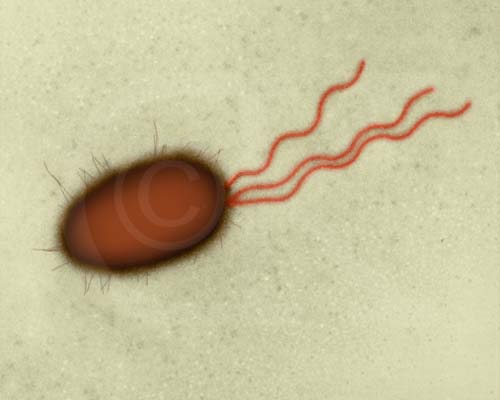Bacterial cell structure
Flagella and their factions: these are extremely thin, hair like appendages. They come out through cell wall and originate from basal body, structure just beneath the cell membrane in the cytoplasm. They are made up of protein Flagellin. On the basis of presence of flagella. Pattern of attachment of flagella and the number of flagella present bacteria are classified into different taxonomic groups.
Atrichous means bacteria are without any flagella. When single polar flagellum is present then condition is known as monotrichous. If tuft of flagella is present only at one pole of bacteria then these are lophotrichous flagella. Amphitrichous is a condition when tuft of flagella at each of two poles is present.

In peritrichous form, flagella surround the whole cell. Most of bacilli and spiral shaped bacteria have flagella. Cocci very rarely have flagella. Primary function of flagella is to help in motility. With the help of flagella, flagellate bacteria can also detect and move in response to chemical signals which is a type of behavior called as chemotaxis.
Pili and their functions
These are hollow, non helical, filamentous appendages. Pili are smaller than flagella and are not involved in motility. True pili are only present on gram-negative bacteria. They are made up of special protein called pilin. They are primarily involved in a mating process between cells called conjugation process. Some pili function as a means of attachment of bacteria to various surfaces.
The cell envelope: The outer wrapping of bacteria
Bacterial surface and walls are very diverse. Collectively complexes of layer external to the cell protoplasm are called as cell envelope and include capsule, slime and cell wall.
Capsule
Bacteria produce capsule, which is made up of repeating polysaccharide units, and of protein, or of both, capsule is tightly bound to the cell. It has a thicker, gummy nature that gives sticky characters to colonies of encapsulated bacteria.
Slime
Some bacteria are covered with loose, soluble shield of macromolecules which is called as slime capsule and slime provides greater pathogenicity to bacteria and protects them against phagocytosis.
Cell wall
Beneath the extracellular substances and external to cytoplasmic membrane cell wall is present. It is a rigid structure. It determines the shape of bacterium. Cell wall also protect the cells from osmotic lysis. Cell wall is only absent in mycoplasmas. Christian gram developed the technique of gram stain.
Bacteria could be divided into two groups based on their response to gram staining procedure. By this staining technique Gram-positive bacteria are stained purple ( retain the primary dye due to formation of CV-1 complex) and Gram-negative bacteria are stained pink (retain secondary dye) in colour.
There are many structural differences between two groups (table 6.1) which are the primary basis for difference in staining behavior.
Table 6.1: Comparison of Gram-positive and Gram-negative cell walls.
|
Characteristics |
Gram-positive |
Gram-negative |
| Number of major layers
Chemical makeup Overall thickness Outer membrane Periplasmic space permeability |
1 Peptidoglycan (50% of dry weight in some bacterial cells) Teichoic acid Lipoteichoic acid Lipids (1-4%) 20-80 nm No Present in some More permeable |
2 Lipopolysaccharides Lipoproteins Peptidoglycan 10% dry weight of some bacterial cells Lipids (11-12%) 8-11nm Yes Present in all Less permeable |
The cell walls of most bacteria have a unique macromolecule called as peptidoglycan. Its amount varies in different types of bacteria. It is composed of framework of long glycan chains cross-linked with peptide fragments.
The intact cell wall also contains chemical constituents such as sugar molecules, teichoic acid, lipoproteins and lipopolysaccharides, which are linked to peptidoglycan.
Several bacterial groups lack the cell wall structure characteristic of gram positive or gram negative bacteria, and some bacteria have no cell wall at all. Cell walls of archaebacteria are different from eubacteria. They do not contain peptidoglycan. Their cell walls are composed of proteins, glycoproteins and polysaccharides.
